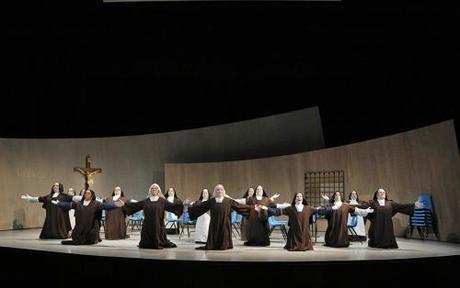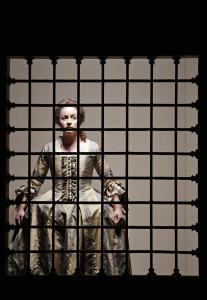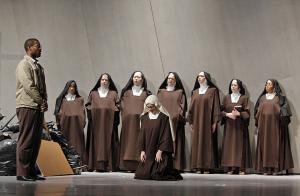
Opertoonity.com Review: Dialogues of the Carmelites
Live Performance
March 9, 2014
Presented by Curtis Opera Theatre, in association with Opera Philadelphia and Kimmel Center Presents
The Perelman Theater, Philadelphia

Voices carry, the saying goes. But can they carry an entire production?
Several of the young voices representing the Curtis Opera Theatre program tasked to sing The Dialogues of the Carmelites at Philadelphia’s famed Kimmel Center were nothing of short of extraordinary. But expecting them to carry a show when the staging and other production elements lacked cohesiveness was asking too much.
The Curtis Symphony Orchestra led by conductor Corrado Rovaris played Francis Poulenc’s capstone opera heroically. Alas, even supremely talented musicians couldn’t rescue a flawed show.
That’s because theater is part of opera. It’s even in the company’s name—Curtis Opera Theatre. If staging, lights, sets, and costumes aren’t as strong as the voices and the orchestra, the whole production suffers. Theatrical elements shouldn’t supersede the voices (and we’ve all seen those operas), but they must inform and lift up the integrity of the whole work.

There aren’t many choral numbers in “Dialogues of the Carmelites,” but this hymn by the sisters was transcendent | photo by Cory Weaver
The selection of Carmelites as the next offering at the Perelman Theater held all the promise for a stunning production. It was the right size show for the space—a 650-seat venue with a modern affect. Curtis Opera Theatre had august partners in Opera Philadelphia and Kimmel Center Presents. However, the devil is certainly in the details for a nuanced masterwork like Carmelites. Critical artistic choices on which the success of the show hinged handicapped this production.
The show lacked artistic coherence. The stage was annoyingly dark most of the time. To open the show, there were three large avant garde looking set pieces layered on the stage, which left little room for natural movement. Despite the modern design introduced, the first costumes seen were completely in period. Between acts, the big trendy set pieces were removed, leaving only one by the end of the show. In the middle of Act II, folding tables like those used at a flea market were hauled out for the scene featuring all the nuns working and singing, and turquoise-colored fiberglass chairs were set out, like those you might see in a local junior high school classroom. In the middle of this act, French soldiers stormed the convent to terrorize the sisters, but the soldiers wore modern dress, wielding hand guns, looking like a street gang from a rough Philly neighborhood. Why this choice was made—to mash up 18th Century French Revolution with 21st Century Street Gang—was hardly evident to this reviewer.
By casually slipping into the modern period midway through the second act, many in the audience were robbed of the power of story at its core: during the Reign of Terror, the Catholic Church was denounced as an enemy of the Revolution. The Church’s properties were confiscated to fill Revolutionary coffers, and women and men religious were branded as traitors. This included an order of devout Carmelite nuns who refused to renounce their faith and are guillotined in a breathtaking scene at the end of the opera. A modern opera set during a brutal and tumultuous period in history past hardly needs updating to remain meaningful.
As the show progressed, clerics came onstage dressed conventionally and came back wearing modern street clothes. It was also never clear that Blanche returned home to find it ransacked, which informed her decision to choose martyrdom. The final pivotal scene in the opera– the execution of the sisters–was even diminished by its staging. The sisters were executed onstage while facing the audience while customary staging of this scene leaves something more to the imagination, yielding significantly greater dramatic impact.

Rachel Sterrenberg as Blanche | photo by Cory Weaver
To sum up, director Jordan Fein (and by association, all the other creatives on the bill) simply missed the mark with this one.
Absent an integrated artistic interpretation, the Curtis students left to bring off the show shone like the future stars they surely will be, very nearly succeeding. Tenor Roy Hage who sang the Chevalier for the closing performance was a magical talent on stage. As Chevalier, his stage time is limited, but his ovation at curtain call was not. In character, he has a luminescent quality about him. His lush lyric tenor enraptured the audience.
Also commendable was soprano Rachel Sterrenberg as Blanche, Chevalier’s sister, who grows up in privilege but abandons it for a life of servitude with the Carmelites. She began a little stiffly in the first act. Once she shed the cumbersome period panniers for a simple nun’s habit, she warmed to her role, becoming a powerhouse by Act III. This was despite some illogical staging that was highly distracting to audience members-yes, a fifth wall was introduced.
Show-stealing honors must go to soprano Sarah Shafer as Sister Constance. Shafer is a gifted actress, and her voice was ideally suited to the role of the novitiate with a lighthearted, readily excitable manner.

Sarah Shafer as Sister Constance | photo by Cory Weaver
As Mme. de Croissy, mezzo Shir Rozzen needed a bed for her death scene but was denied that simple set piece which would have helped tame her character who could only bust out all over the stage singing her dying aria.
Did the careless direction detract from Poulenc’s masterful score? Unfortunately it did, which might be the single worst shortcoming of this production, that it lacked a proper showcase for a seminal work.
Kudos to all the performers and musicians–you tried valiantly to carry this production. But in a perfect opera world, you shouldn’t have to do all the heavy lifting.

